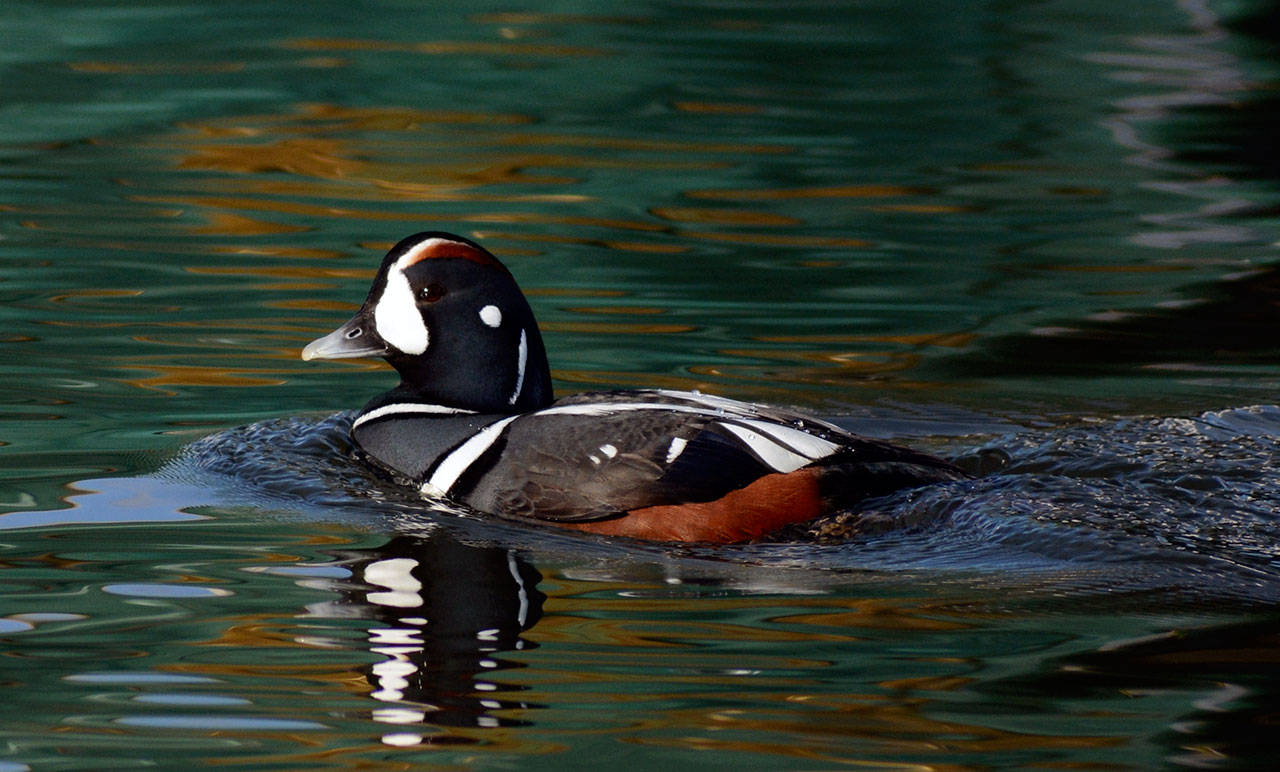By Dianna Moore
Grays Harbor Audubon Society
The Harlequin is a fairly rare duck not often seen on the Harbor, so when someone finds one it causes a bit of a stir among birders.
General Description: The Harlequin Duck is a small seabird with a short bill and what Cornell Lab of Ornithology calls an “extravagantly marked” slate blue body with chestnut brown flanks and crown patch, and bold white stripes on face, neck, sides, and back. Non-breeding males are mostly brown with a white patch behind the bill and a round white spot behind the ear. He also has a subtle white shoulder stripe and white on the wings, while the females and juvenile males are without those white touches. The male is also a bit bigger with length at 13.4 to 18.1 inches, weighing 17.3 to 26.8 ounces, and a wingspan of 22.1 to 26.0 inches. The female is 13.0 to 16.5 inches in length and weighing 16.6 to 23.6 ounces.
Habitat: These ducks prefer turbulent waters, hanging around fast-moving mountain streams during breeding season with mid-stream gravel bars or rocks for roosting. During winter they can be found along rocky, intertidal coastline.
Behavior: Harlequins are able to easily clamber over steep and slippery rocks though many are found with evidence of broken bones from being dashed against those rocks. They are able to swim against the current, walk on the bottom of the stream and forage under water like other dabbling ducks.
Diet: In their winter coastal habitat mollusks and crustaceans and some small fish and marine worms add to their daily take. In fast-moving streams they are able to eat their fill of aquatic insects and especially the larvae attached to rocks under water.
Nesting: Breeding success is at a low level until Harlequin Ducks reach the age of five. The ducks form a pair bond in the winter and spring Their nest is located near a stream, on the ground, on a small cliff edge, in a tree cavity or in a stump. It is a shallow depression
lined with soft vegetation and down. The female incubates five to seven eggs for 27 to 30 days. The male leaves the breeding grounds when incubation begins to go off and molt and will rejoin his mate in the fall on the wintering grounds. The young leave the nest shortly after hatching but stay nearby while the female tends them and shows them good feeding areas. They are able to dive but find most of their food on the surface at first. It isn’t unusual to see several broods joining together and tended by more than one female.
Migration: Harlequin Ducks are short-distance migrants, leaving the coast in mid-March for breeding grounds above 4,000 feet in the Olympic, Cascade or Selkirk Mountains. They return in September.
Conservation Status: The population of Harlequin Ducks is currently stable but they remain subject to many potential threats from logging. In particular removal of forest from stream-sides and the resultant silting. kills off their prey. They are also the victims of oil spills, derelict nets and hunting.
When and Where to Find on Grays Harbor: The best time to see Harlequin Ducks is between September and March, and the best places to see them is generally around the Westport Marina, the channel between Westport and Ocean Shores, and in some streams and ponds near the coast. With all those colors, this should be a snap if they are around.


